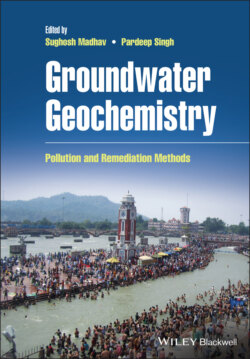Читать книгу Groundwater Geochemistry - Группа авторов - Страница 31
1.6.3 Chromium
ОглавлениеChromium mostly occurs in trivalent and hexavalent forms depending on pH. In shallow aquifers, Cr (VI) is the dominant and toxic form, and its major species include chromate CrO4−2 and dichromate Cr2O7−2 (especially Ba2+, Pb+2, and Ag+) (Hashim et al. 2011). At low pH (<4), Cr (III) is the dominant form of Cr. In soil organic matter, S2− and Fe2+ ions under anaerobic conditions lead to the reduction of Cr (VI) to Cr (III) (Hashim et al. 2011). The Cr (VI) has higher mobility and toxicity than Cr (III), and it is more problematic to eliminate Cr (VI) in water. In water, chromium (III) is typically present as the free‐ion state, but it is also related to hydroxide ions depending on pH and forming chromium (OH)2+, chromium (OH)2+, chromium (OH) 3, and chromium (OH)4−. The major Cr species found in aqueous solution are SO42−, NH4+, and CN; these are formed by complexes of Cr3+ with organic and inorganic ligands. The equilibrium of Cr among the two oxidation forms has relied on oxidation kinetics which further depends on biochemical settings, such as pH, redox, and nutrient levels that direct microbial activity (CGWB 2014).
Chromium has been found in diverse parts of India. Its source has been generally attributed to anthropogenic inputs. However, chromite deposits in the Sukinda area of Orissa are identified as geogenic sources. In the Sukinda area, the lateralization progress including oxidation and change of the serpentines generates alkaline pore water which enables the formation of Cr (VI) from the inactive chromites and leads to chromium pollution of water in and around the area (CGWB 2014).
